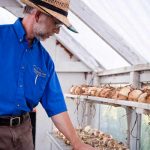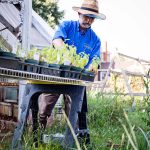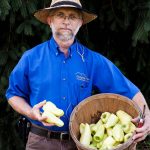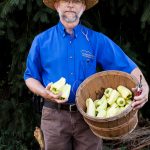The best ideas are usually the most obvious ones. Michael Reeps stood on stage in front of a crowd of Staunton, VA residents. He proposed an idea he’d been scheming for a while. Reeps is a web developer and designer. He recognized the interest in local, fresh food around Staunton and the Shenandoah Valley. He saw consumers and producers living within a half-hour of one another. He wanted to bring them together in the arena where he worked – the good-old Internet.
With farmers markets on the rise throughout the country in the last two decades, it’s no surprise that the trend for easy access to local growers would move into the online world. Localharvest.org has been a big player in the national field of websites connecting consumers to small, local, organic producers. It’s like Google for local food.
Staunton, VA, with a population of 25,000, is like a mini east-coast version of California’s Santa Cruz Valley. There are no surf waves, but an active local food community and a diverse web of small growers, ranchers, and producers live within a short drive from one another. The Shenandoah Valley’s rich soils and climate make the long southwest-to-northeast-trending valley a bread-basket for Virginia. Staunton’s Augusta County and Rockingham County to the north are the top two agriculture producers in the state, much of it being large-scale poultry and some corn and soybeans.
The historic downtown has a couple restaurants that get regular attention in foodie magazines. A man who used to bake bread out of his barn in the countryside has moved into downtown and runs the town’s best bakery. Joel Salatin, of Polyface Farms and The Omnivore’s Dilemma lives a half-hour away.
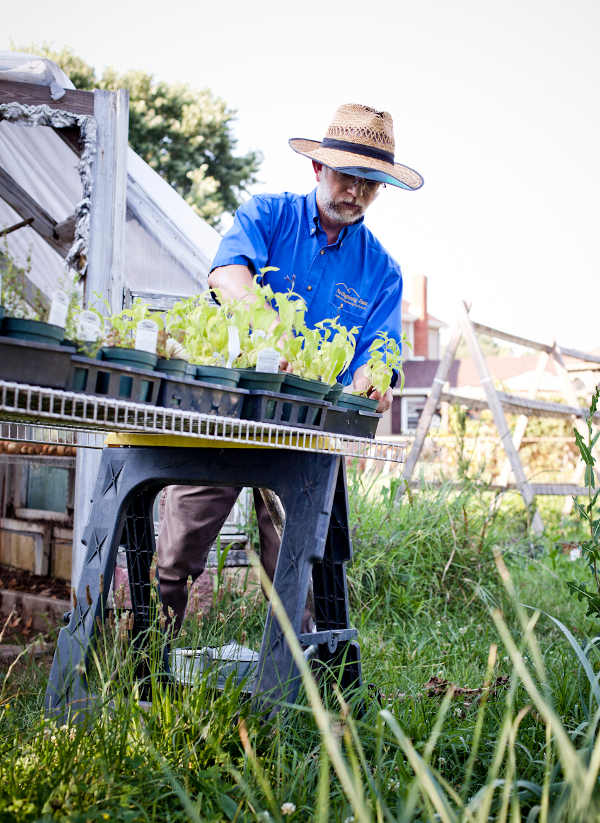 But even here, farmers find it hard to market their local, often organic products. And there’s a major disconnect between the high-end food products in main street stores and the low-income residents who live on the edge of town and beyond.
But even here, farmers find it hard to market their local, often organic products. And there’s a major disconnect between the high-end food products in main street stores and the low-income residents who live on the edge of town and beyond.
The Staunton Creative Community Fund, founded in 2008, has three staff in an upstairs office of the old buildings along Byers Street in downtown Staunton. They act behind the scenes, seeking ways to “create space” for new, small businesses in Staunton’s arts, culture, and food world. In 2011 they received a one-year USDA’s Community Food Project (CFP) grant to assess the community in terms of food access and ways to broaden the web among consumers and producers. They found that there was a need for community kitchen space – in churches, schools, etc – for use by small, food business ventures. They are now hoping for a USDA implementation grant to make that happen so small businesses don’t have to face the steep uphill climb of finding or building their health-department-approved kitchens.
The Staunton Creative CFP study also found a need for new ways to bring the food being grown nearby into the population center of Staunton. In an offshoot to the CFP assessment and planning work, they hosted an Ignite series of events and Staunton Creative, through a non-USDA-related grant, offered $5,000 to the best new business idea that would add value to the community.
Enter Michael Reeps and his pitch that night to create Staunton Fresh, an online farmers market.
“We had been trying to gain momentum for a community-supported food co-op in Staunton,” says Reeps. “But we just couldn’t quite get it going. The online market works in a similar fashion, in that it requires a membership fee to join. That upfront fee supports the basic infrastructure of a website. Members can then access the farmers within the system.”
The membership and market-rate approach has its downsides, first and foremost being a price barrier for low-income residents who don’t have internet and can’t pay a membership fee. But the upside to the online concept of Staunton Fresh is that it has real roots. Real farmers within the local economy supply the food being seen and ordered on the website. Farmers like John Matheney and his Nu-Beginning Farm.
In 2001 John and Stella Matheney moved from Lynchburg to get away from things and grow food and experiment with selling that food. They wanted a flat lot, a 5,000 square foot garden (or so), a root cellar, a storage cellar, a barn, and an orchard. They found all of it in the tiny blip-on-the-road town of Greenville, VA, about fifteen miles south of Staunton.
John had been a manager of restaurants, even some fast-food restaurants. Stella had an office job with Swedish communications tech company, Ericsson. Neither had any farming experience, though John’s grandparents were avid gardeners. “My grandpa as a mad scientist farmer,” says John. “He wanted to get the tallest corn and sunflower in the county so he tinkered with everything. My grandmother wanted to pack as much food onto the shelves in cans and preserves as possible. She was the producer. I guess I got a little of both.”
They started farming like his grandma had – with powerful fertilizer and pesticides. But they slowly moved into organic, the better for John’s tinkering mind. Plus, as he says, “The older you get, the more you cling to life. I knew those chemicals were no good for us.”
As he began selling the organic produce at the Verona Farmer’s Market he realized a sort of divide among the shoppers. The younger generations wanted the organic stuff, while the older retirees scoffed at “organic” or “chemical-free” labels, saying the price was too high. John saw them occasionally walk away from his organic squash and buy the same thing, for more, at another table. So Nu-Beginnings doesn’t advertise “organic” too much. Here in the rural south, the same phenomenon occurs as in West Oakland where “organic” stirs up all sorts of elite, negative notions.
John is an ambitious grower, and he’s always looking to expand his market, whether it’s through his experiments with preserves and pickled fruits and veggies, or through the new Staunton Fresh website. The online market will allow him to sell all year, especially the value-added products. He says he’s not worried about the potential for too much demand at inopportune times because he gets to make available only the products he has on hand at the time. It’s real-time shopping all day, everyday, rather than having to wait until a weekly farmer’s market schedule. John says that, as a producer, there’s a luxury in the omnipresence of an online market, and that’s comforting.
 On the consumer side, the challenge in Staunton still exists – how to connect the healthy local food growing so close to the city, with the low-income residents who need it? Michael Reeps hopes Staunton Fresh will emerge into a viable marketplace with a strong enough foundation of market-rate customers that they can create space for reduced-rate memberships for low-income residents. It’s an experiment and the Shenandoah Valley has proved a good place for food innovation.
On the consumer side, the challenge in Staunton still exists – how to connect the healthy local food growing so close to the city, with the low-income residents who need it? Michael Reeps hopes Staunton Fresh will emerge into a viable marketplace with a strong enough foundation of market-rate customers that they can create space for reduced-rate memberships for low-income residents. It’s an experiment and the Shenandoah Valley has proved a good place for food innovation.
The best ideas are usually the most obvious ones. Michael Reeps stood on stage in front of a crowd of Staunton, VA residents. He proposed an idea he’d been scheming for a while. Reeps is a web developer and designer. He recognized the interest in local, fresh food around Staunton and the Shenandoah Valley. He saw consumers and producers living within a half-hour of one another. He wanted to bring them together in the arena where he worked – the good-old Internet.
With farmers markets on the rise throughout the country in the last two decades, it’s no surprise that the trend for easy access to local growers would move into the online world. Localharvest.org has been a big player in the national field of websites connecting consumers to small, local, organic producers. It’s like Google for local food.
Staunton, VA, with a population of 25,000, is like a mini east-coast version of California’s Santa Cruz Valley. There are no surf waves, but an active local food community and a diverse web of small growers, ranchers, and producers live within a short drive from one another. The Shenandoah Valley’s rich soils and climate make the long southwest-to-northeast-trending valley a bread-basket for Virginia. Staunton’s Augusta County and Rockingham County to the north are the top two agriculture producers in the state, much of it being large-scale poultry and some corn and soybeans.
The historic downtown has a couple restaurants that get regular attention in foodie magazines. A man who used to bake bread out of his barn in the countryside has moved into downtown and runs the town’s best bakery. Joel Salatin, of Polyface Farms and The Omnivore’s Dilemma lives a half-hour away.
But even here, farmers find it hard to market their local, often organic products. And there’s a major disconnect between the high-end food products in main street stores and the low-income residents who live on the edge of town and beyond.
The Staunton Creative Community Fund, founded in 2008, has three staff in an upstairs office of the old buildings along Byers Street in downtown Staunton. They act behind the scenes, seeking ways to “create space” for new, small businesses in Staunton’s arts, culture, and food world. In 2011 they received a one-year CFP grant to assess the community in terms of food access and ways to broaden the web among consumers and producers. They found that there was a need for community kitchen space – in churches, schools, etc – for use by small, food business ventures. They are now hoping for a USDA implementation grant to make that happen so small businesses don’t have to face the steep uphill climb of finding or building their health-department-approved kitchens.
The Staunton Creative CFP study also found a need for new ways to bring the food being grown nearby into the population center of Staunton. In an offshoot to the CFP assessment and planning work, they hosted an Ignite series of events and Staunton Creative, through a non-USDA-related grant, offered $5,000 to the best new business idea that would add value to the community.
Enter Michael Reeps and his pitch that night to create Staunton Fresh, an online farmers market.
“We had been trying to gain momentum for a community-supported food co-op in Staunton,” says Reeps. “But we just couldn’t quite get it going. The online market works in a similar fashion, in that it requires a membership fee to join. That upfront fee supports the basic infrastructure of a website. Members can then access the farmers within the system.”
The membership and market-rate approach has its downsides, first and foremost being a price barrier for low-income residents who don’t have internet and can’t pay a membership fee. But the upside to the online concept of Staunton Fresh is that it has real roots. Real farmers within the local economy supply the food being seen and ordered on the website. Farmers like John Matheney and his Nu-Beginning Farm.
In 2001 John and Stella Matheney moved from Lynchburg to get away from things and grow food and experiment with selling that food. They wanted a flat lot, a 5,000 square foot garden (or so), a root cellar, a storage cellar, a barn, and an orchard. They found all of it in the tiny blip-on-the-road town of Greenville, VA, about fifteen miles south of Staunton.
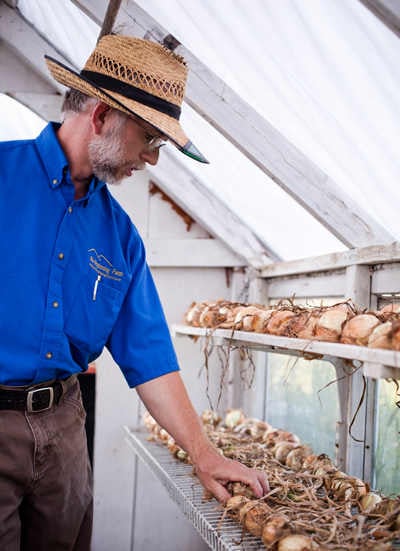 John had been a manager of restaurants, even some fast-food restaurants. Stella had an office job with Swedish communications tech company, Ericsson. Neither had any farming experience, though John’s grandparents were avid gardeners. “My grandpa as a mad scientist farmer,” says John. “He wanted to get the tallest corn and sunflower in the county so he tinkered with everything. My grandmother wanted to pack as much food onto the shelves in cans and preserves as possible. She was the producer. I guess I got a little of both.”
John had been a manager of restaurants, even some fast-food restaurants. Stella had an office job with Swedish communications tech company, Ericsson. Neither had any farming experience, though John’s grandparents were avid gardeners. “My grandpa as a mad scientist farmer,” says John. “He wanted to get the tallest corn and sunflower in the county so he tinkered with everything. My grandmother wanted to pack as much food onto the shelves in cans and preserves as possible. She was the producer. I guess I got a little of both.”
They started farming like his grandma had – with powerful fertilizer and pesticides. But they slowly moved into organic, the better for John’s tinkering mind. Plus, as he says, “The older you get, the more you cling to life. I knew those chemicals were no good for us.”
As he began selling the organic produce at the Verona Farmer’s Market he realized a sort of divide among the shoppers. The younger generations wanted the organic stuff, while the older retirees scoffed at “organic” or “chemical-free” labels, saying the price was too high. John saw them occasionally walk away from his organic squash and buy the same thing, for more, at another table. So Nu-Beginnings doesn’t advertise “organic” too much. Here in the rural south, the same phenomenon occurs as in West Oakland where “organic” stirs up all sorts of elite, negative notions.
John is an ambitious grower, and he’s always looking to expand his market, whether it’s through his experiments with preserves and pickled fruits and veggies, or through the new Staunton Fresh website. The online market will allow him to sell all year, especially the value-added products. He says he’s not worried about the potential for too much demand at inopportune times because he gets to make available only the products he has on hand at the time. It’s real-time shopping all day, everyday, rather than having to wait until a weekly farmer’s market schedule. John says that, as a producer, there’s a luxury in the omnipresence of an online market, and that’s comforting.
On the consumer side, the challenge in Staunton still exists – how to connect the healthy local food growing so close to the city, with the low-income residents who need it? Michael Reeps hopes Staunton Fresh will emerge into a viable marketplace with a strong enough foundation of market-rate customers that they can create space for reduced-rate memberships for low-income residents. It’s an experiment and the Shenandoah Valley has proved a good place for food innovation.


